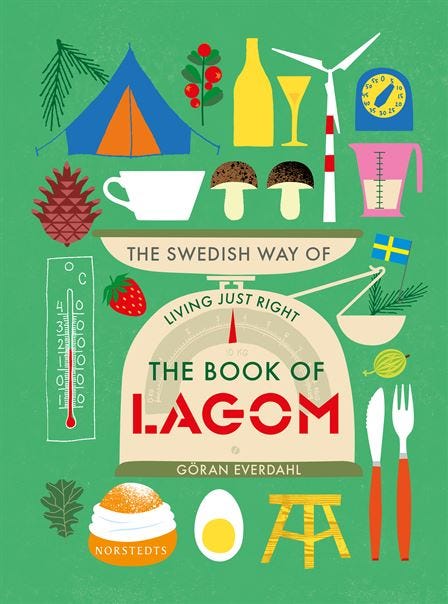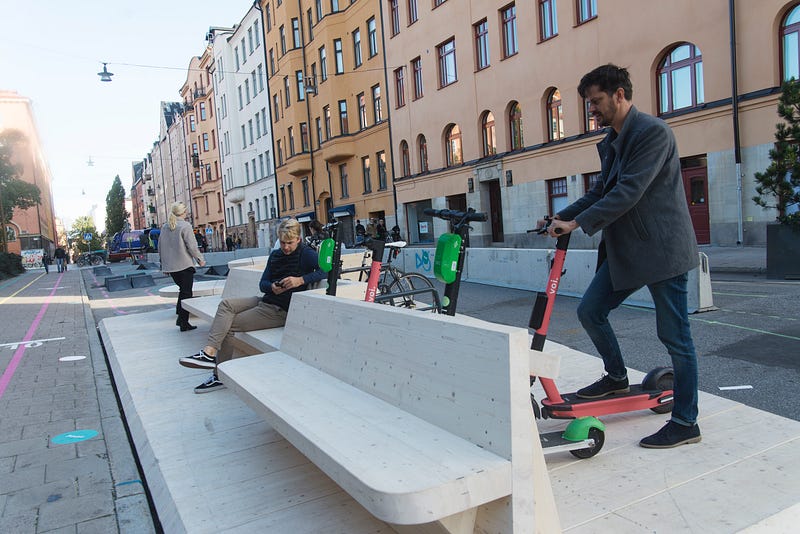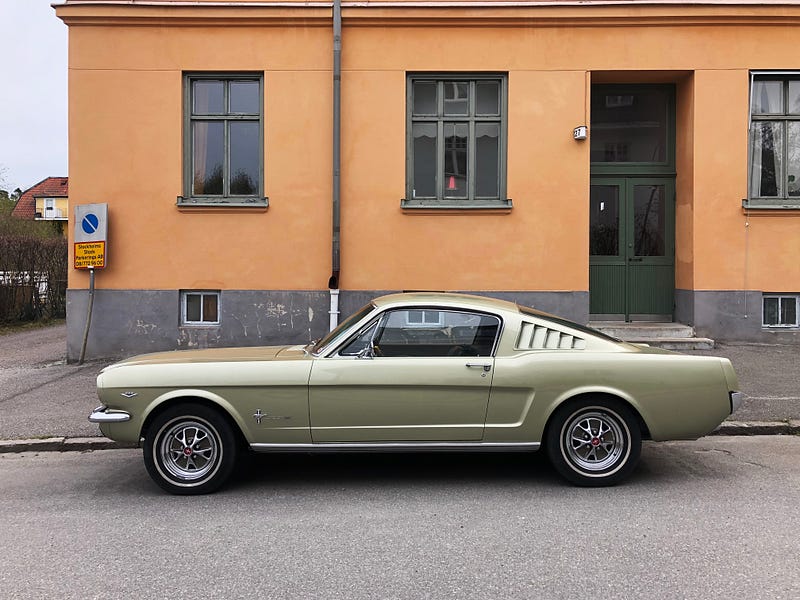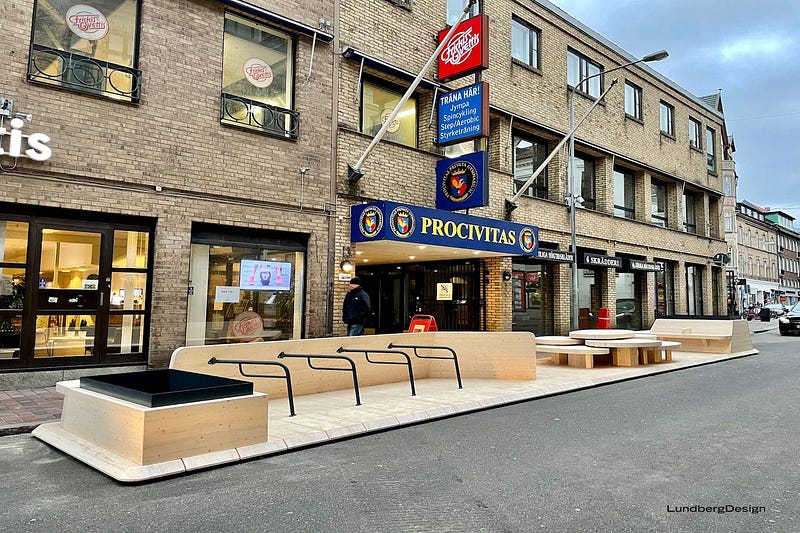Co-opting a loose word—the Swedish concept of ‘lagom’—and redeploying it for our streets and neighbourhoods
Working on numerous urban mobility-related initiatives here in Sweden, and running design workshops with stakeholders from municipalities, regional and national government, transport agencies, Volvo, MoveByBike, Voi and many others, I started stringing together a phrase, ‘lagom mobilitet’ to describe how we might better calibrate our mobility to our spaces, looking to fit, calibrate and refine the mobility options into the space, with a little more humility, grace and care, rather than the other way around.

Lagom is a Swedish word that is notoriously difficult to translate precisely and perhaps as a result captures a usefully flexible ethos. It has irritatingly generated hundreds of self-help and lifestyle books accordingly, shuffling along behind hygge and ikigai and the like, in airport bookshops. Lagom is usually translated as ‘just enough’, or ‘just right’, or ‘good enough, given the situation’ or ‘nothing special but perfectly fine’ or ‘not too much and not too little’— or simply ‘appropriate’. (Though it’s worth noting that it can also have the air of ‘a bit crap’, or ‘certainly in no way great … but not bad’, which conjures aspects of the sometimes downbeat, ascetic Nordic sensibility.) It is not as cosy, warm, and positively glowing as hygge, nor with the apparently existential quest of ikigai. Instead, ‘it is what it is is’ would be an almost lagom way of discussing definitions of lagom. It is a feeling rather than a measurement, but has the air of a measurement.
And mobilitet is mobility, of course. So lagom mobilitet suggests ‘just the right mobility for the context’.
This shaping of services, spaces and infrastructures in line with context—proximity, condition, sensibility, culture—is increasingly familiar thanks to the nested Matryoshka dolls of 60-minute, 30-minute, 15-minute, one-minute cities.
It asks us to understand a place—its needs and desires, from human and increasingly more-than-human perspectives—and make the supporting infrastructure work on its terms, rather than the other way around. That sounds like common sense, but we must reflect that we haven’t been doing that for a century or so. Every freeway rammed through a local community is an example of the opposite: the local culture obliterated by inappropriately dominant infrastructures, harming people and place for the sake of somewhere else. I live near one in Stockholm; you probably do too.
Every time a large garbage truck rumbles through your street, we might feel that this is not-so-lagom. We might see the same careless pattern in other infrastructures, like energy or waste, as well as in buildings. It might also apply to parks, shopping malls, and other remnants of the ‘build it and they will come’ compound growth-led investment model, which sees the city as a vehicle for exploitation. Such projects tend to over-scale accordingly.
Those patterns, perhaps most obvious with mobility, are not simply questions of quantifiable scale, but also of character, performance, openness, adaptability. The city is bent to fit the vehicle, rather than the other way around (as in, But what was the question?).
A vague and well-meaning sensibility like lagom is not enough to resist all that, of course, when applied to these more meaningful questions of culture and life — and please let no-one suggest a Lagom City strategy . But as a short-hand, hovering ambiguously between qualitative and quantitative readings, it may be useful in the context of mobility in particular, where we have instead tended to impose over-sized, noisy and polluting vehicles onto natural urban environments.


Lagom mobility
Put simply, this could be an organising principle for vehicles in the city, to be defined and managed by municipalities or equivalent, perhaps increasingly in real-time, and crucially, articulated via engaged, participative governance cultures, and oriented towards our grand challenges, such as environment, health and social justice.
The principle would involve vehicles in the city being ‘sized and profiled’ to match their environment appropriately, based on the context of the street, essentially, and nurturing the environmental systems—including us—that inhabit it.
Put simply, you couldn’t drive a large, noisy, smelly garbage truck on a small street with a kindergarten on it. Instead, the recycling for the street can to be picked up by a few cargo e-bikes instead, and ideally not when the kindergarten is active. The mobility service in that scenario is clean, quiet, green, slow and adapted to the place. In this case, imagine how a kindergarten might want to spill out its activities onto a street, such that the street is akin to a garden, a playground, a park as much as it is a thoroughfare for some. That’s the context. We work around that.
The current model would instead tend towards a large garbage truck doing this job, for reasons of efficiency (which is often a cul-de-sac when applied to urban thinking.) It is scaled indeterminately for all streets in the city—and thus none of them in particular—and procured at scale. It forces the street to work on its terms, rather than the other way around. Businesses and institutions (like kindergartens) can’t ‘spill out onto the street’, due to safety, health and environmental qualities like noise and fumes. The pavement is scrubbed bare of street trees and furniture so that trucks (and street cleaners, snow clearers etc) can easily move down them (despite street trees actually reducing accidents—a data point for another post.)
If our starting point is instead a place defined by nature — people and otherwise — with a broad and diverse set of regenerative interactions and relationships, the mobility has to respectfully ‘size itself’ to fit into that place, not the other way around. That place includes the nature—again, including us—that we want to physically and culturally thrive there, so that is the starting point. Small street probably means small, quiet vehicles. Medium-sized street means medium vehicle. Big street, and big vehicle may be fine. Maybe. Unless that big vehicle has an outsize impact on the small things that might also be on and around the big street. A freeway outside the city has its own environmental profile to shape it—and so trucks and buses should be fully electric, powered by renewables, and moving relatively slowly so that their tire noise does not disturb nearby biodiversity, and so on—but a large truck can likely find a way to exist in this space.
Between these poles, a ‘gradient’, or spectrum, of calibration.
This is not simply about size. Small should probably also be slow. Delightfully slow. The array of lagom qualities moves beyond spatial impact to include emissions, such as noise and fumes, as well as speed, with safety, conviviality and respect for others in mind.
In doing all this, of course, we start looking at shaping demand and supply more in unison. It opens up the question of moving less, or being aware of moving goods as little as possible (whilst still having a functioning and meaningful local economy.) Lagom suggests the necessary balancing act of city life, not total erasure. But it does also suggest a recalibrating of that balance, towards life rather than efficiency.
Equally, the volume of vehicles can be tuned too, as four cars in a line is effectively the same as a large truck, even if each, individually-speaking, is relatively smaller. So the lagom principle can be applied to the number of private cars on a street, too. Thanks to models like car sharing services, this becomes possible. Research from Volvo M (who were part of the original workshops, and a ‘sparring partner’ in Vinnova’s subsequent development work) shows that one shared car can capably do all the jobs of seven private cars. So we might assume we can easily release, let’s say, four or five parking spaces in favour of one shared car spot.
So now we can ask what is the lagom amount of cars for this street? In this neighbourhood? In that discussion, we’re balancing the tasks and desires at hand, and the need for a bit of flexibility, with the context. This is both qualitative and quantitative, but it asks us to check our assumptions—it is not simply one or two cars per household (the standard parking minimum approach, in which cars simply increase ad infinitum, as if a law of physics) but rather framed by questions of biodiversity, health, social life, culture, local economic resilience, and so on.
That same lagom question can be applied to e-scooters. Personally, having discussed it a lot over the last two years, with numerous diverse stakeholders, I remain convinced that, if handled well, e-scooters are a valuable, potentially sustainable, social, healthy, clean, spatially-sound, and fun way to move around the city. They fit neatly into the ‘XS’ bracket of the mobility spectrum, alongside bikes, wheelchairs, sleds etc. But clearly, there is an upper limit for the number of scooters a city needs, and this probably needs to be shaped by active procurement or licensing of one or two players per city, by the municipality, using a set of conditions (around safety, sustainability, parking, data-sharing, and so on). Scooters probably should not be everywhere, and thus so-called ‘floating parking’ cannot be everywhere either. So as with cars, which originally had ‘floating parking’ too until some municipality started creating parking spaces, the municipality should probably offer scooter parking, alongside bike parking, social space, planting etc, in coherent mobility hubs, at the end of most streets, and so substituting out on-street car parking spaces to make room for them, and using shared public data to understand how to better match supply and demand (In other words, the Street Moves model.) This requires a short walk to and from that shared scooter bay (as with bikes and car parks)—but what a lagom solution! The scooter is not right outside your destination, and you have to do a bit of a walk from the end of the street. But that’s OK, right? So again, the discussion may be best framed by the possibility in this lagom sensibility, the ‘happy-enough’ compromise.

The characteristic of the vehicles then, are also relevant. With scooters, it’s the sometimes chaotic variability and unpredictability, where just a touch of predictability would help massively. But larger, heavier vehicles, like cars and vans, dominate spatially, aggressively reducing openness and adaptability. Unless it’s a tiny car, but we know the tendency in recent years has been the complete opposite of that, witnessing the rise in popularity of SUVs, alongside governments blithely ignoring the impact of these unbelievably damaging vehicles.
Ed. Now I'm in Australia, some months after writing this, SUVs dominate the urban environment more than I imagined possible, in a more American condition. Trying to cycle alongside them, on a small roads, brings this point home more than any amount of data. This unconscionably lazy shift to SUVs may be one of the last kicks of the extractive age — or a sign of its continued dominance — but either way is hugely problematic.
Put such a car in a parking space and that shared public space becomes temporarily privatised; the car is mutually exclusive, and aggressively so. It is not lagom at all:
If Amazon is the bar set for appropriateness there, something is really up. Somehow, a gas-guzzling vintage Alfa Romeo, glugging along slowly, would be more appropriate for an urban condition than these SUVs, which not only produce excessive carbon at every point of their existence, but hugely unsafe whilst they are moving. They shape the character of the street (much as research into car drivers suggests it shapes their characters; or, as this lovely research puts it: “self-centred men who are argumentative, stubborn, disagreeable and unempathetic are much more likely to own a high-status car such as an Audi, BMW or Mercedes”.)

Ed. A diagram or two will follow all this, I expect.
And from a logistics point-of-view, that reduction begins to suggest another idea: the packet-switched logistics network, in which we might genuinely wrestle with the mobility impact of e-commerce from this lagom point-of-view. Here, goods, or other logistics like waste, must switch across modes, moving up or down through the scales, ‘packet-switching’ into separate smaller vehicles, as required. Utrecht is a good example of this in action, and sitting alongside exemplary mobility infrastructures for cycling. Cargo bikes can indeed carry much of the logistics required—around 85% of all deliveries, according to analysis of Berlin—and easily fit into the streets, rather than the other way around.
Other forms of enabling function, like street cleaners, can also be tuned in this way of course. Nor would this preclude those moments when a large truck is genuinely required—the odd occasion in which someone moves house or apartment and requires a removal van. The directive is simply not to build the street as if it is all removal vans, all the time. What is driving the decision-making: efficiency or quality? The oblique and ambiguous qualities of lagom deliberately force us to explore the latter.
As geofencing becomes possible, cities like Stockholm or Zürich or Singapore will no doubt look to build digital management platforms that manage these flows. This may or may not be advisable—as ever, it depends massively not only on technical execution, but more importantly on who is running the systems, holding the data, articulating the interfaces, making the decisions, and making them legible and open. If the system is owned and articulated by a legitimate public body who, crucially, is acting as one, seeing and conveying the city as a public good via such systems, then geofencing could be a worthwhile enabling condition. The Zona a traffico limitato (ZTL) in old Italian cities is already achieving this to some extent, via the simple tech of number plate-recognising cameras—though that system has its own issues, and doesn’t quite have the context-based gradation that the lagom principle suggests. It is rather binary, rather than the more acute and varying focus on balancing diverse contexts and diverse vehicles implied above.
Tokyo has more or less been achieving its own version of lagom mobilitet without such code. Or at least, without that kind of code. The small, humane streets that comprise many suburbs in this sprawling metropolis inherently produce fleets of small vehicles at slower speeds, whether for personal use, logistics, trade or services, as I documented here.

Again, the city comes first, and the vehicles have to fit in. And here perhaps we see a way forward without technical control, but instead offering a sense of neighbourhood-scale diversity and invention – and yet still built around walking, cycling, rolling… and life.
By way of comparison, another megacity, New York, is almost an object lesson in the opposite of lagom (and clearly proud of it.) In many American cities, we see the same pattern, still being played out, such that this project can win an quality of life—and the uproar to that perhaps tells us times are a changin’.
Consider the archetypal American school bus. This is clearly iconic in many ways, and a wonderful beast, perhaps in the same way that a Triceratops was. But it clearly has more in common with a World War II troop carrier than its lagom mobilitet equivalent method for getting kids to school: the walking school bus.




And yes, in the US context, the latter walking school bus seems almost clichéd and twee, particularly in comparison to thrusting, snarling, thunderously-loud Roarkian urgency and cacophony of Manhattan, a suburban image rather than urban.
But why is that? School kids from Helsinki and Tokyo walk to school, more or less by themselves, from the age of six, in urban conditions (and whilst some New Yorkers may quibble that Helsinki barely qualifies as ‘a city’ at all, let’s just agree that they cannot level the same accusation at Tokyo.)
Partly the assumptions are due to a lack of protective social fabric, which has clearly been rent asunder in many American cities because reasons. But some of these reasons do concern the symbiotic relationship between social fabric and the built environment, systems and infrastructures that we have built within them. In reality, kids are clearly far more threatened by heavy, fast-moving and polluting traffic than knife-wielding serial killer, despite what misanthropes like Elon Musk might believe. Fix the former, and there is no reason why the walking school bus can’t work in all urban conditions, including the Lower East Side. (Japanese research suggests that kids walking to school is partly helped by Japan’s low crime rate. But is there a symbiotic relationship? That kids on the streets, and the transformed active, healthy and convivial streets that this in turn produces, helps with that low crime rate? Urban history would suggest this is likely.)
Look again at those images of the US school bus, and wonder why we have had to build a snarling armoured battle-cruiser to move kids safely through their urban environments. Yes, the throaty roar and distinctive yellow livery of the school bus has character, akin to the black Tokyo Toyota taxis or red London buses. But a line of walking schoolchildren actually has more character, chattering and twittering and laughing and darting to and fro, with endlessly-shifting, adapting colourful diversity, distinctive to its place and time, and actually capable of being in the landscape without destroying it.
Who, or what, have we been building cities for?
Part of the issue here, as indicated in my discussion of Harry Rutter and Trisha Greenhalgh’s analysis of contemporary policy-making’s tools of analysis for such things, is a lack of systemic understanding of the value of interventions like the walking school bus. Accordingly, our work on the value model underpinning such decision-making cultures is helping support these lagom ideas, although either way, we need to start making the change before we can start making the evidence:
“In contrast to the ‘evidence-based paradigm’, I read in Greenhalgh a preference for ‘down to earth’ engagement with context, locality, culture, and complexity, which can only be pursued with care, with genuine engagement, with practice, and with agility and openness to unforeseen outcomes and uncertainty, set ideally within a context of deep participation.” (Me, here)
Cars and trucks and things that can go
Another ‘cat on the table’ here concerns emergency services. These tend to deploy a class of vehicle that planners have used to over-scale streets, scrubbing them clean of life in favour of a smooth thoroughfare, just in case a fire engine needs to get through. Yet conversations with my old colleagues at Arup remind me that new buildings should rarely burn in any meaningful sense (despite being increasingly made of combustible materials again), and can have fire protection and equipment built-in. In that scenario, a ‘fire truck’ could become a much smaller vehicle, essentially carrying only fire-fighters, who would use equipment in-situ. Older buildings need such fire protection installed anyway, and fire departments have long lobbied for this need to prevent or mitigate fires at source, rather than having to fight them in unbelievably dangerous conditions. This would be an upstream principle, which in turn supports this lagom approach of more open, adaptive streets.
With healthcare—and ambulances specifically—a one-minute city approach would mean each institution (such as the mythical kindergarten above) has good first aid training and basic equipment installed. At the 15-minute city scale, neighbourhood health centres deal with the next most-serious array of emergencies. And larger hospitals—at the 40- to 60-minute city scale—pick up the specialist concerns. The previous centralising trend for ‘super-hospitals’, ferrying everyone to and fro, produces so many problems generally. A distributed ‘post-traumatic urbanism’ model may make greater sense.
Such upstream thinking also suggests a ‘small pieces, loosely joined’ networked pattern of neighbourhood police stations—like Studio Gang’s Polis concept—as well as motivating for police in smaller vehicles, even increasingly on bikes and e-bikes, or simply the ‘bobby on the beat’ neighbourhood policing-on-foot that politicians of all stripes tend to romantically conjure with.

Of course, remove the cars in the volumes suggested above, and we have less need for as many ambulances, police cars, snow clearers, street cleaners in the first place. A largely, though not fully, car-free urban environment is cleaner, safer, greener and with reduced crime, increased health, and enriched social fabric—and much more besides.
What is holding us back, precisely? Even car companies are thinking differently these days; listen to Volvo Cars CEO Håkan Samuelsson and this lagom possibility appears within view.
“In the old school, a car was something you bought. It took me back to when I [first] bought a car … People don’t necessarily want to own a car, but they want the mobility, the freedom to move … In big cities, the private car is not a very practical concept. Maybe it’s time for a new concept but I don’t think the private car can solve that really — probably more biking or walking.”
—Håkan Samuelsson, CEO Volvo Cars (emphasis added)
Essentially, we initiate a project that intends to limit the number of cars in the city — which is fully in line with our company’s purpose.”
—Håkan Samuelsson, CEO Volvo Cars (emphasis added)
This all suggests a variant on that well-tempered environment notion (albeit in a quite different context to Banham’s, and with different technologies for different outcomes.) But it also implies the issues freighted along with that concept: as in, Who is the composer or conductor in this well-tempered environment? Hence the need for the highly participative, hyper-local models of participation and shared ownership discussed in the one-minute city model.

All this talk of small-ness and slow-ness, doesn’t mean any diminution of urban ambition or possibility. Boosters for ‘big’ tend to be in thrall to the shallow and destructive Randian qualities of an extractive, individualistic and patriarchal age. ‘Small’, in this context, suggests a diverse networked urbanism at scale, and this ability to see both the instance and the pattern is key to understanding cities—from the door-handle to the district, the spoon to the city, the seed to the forest.
After all, to make something properly big, like Tokyo or the internet, you need to understand small.
Lagom mobilitet emerged from workshops run over the last two years, and keeps cropping up as a kind of guiding principle in our design discussions about streets and neighbourhoods, particularly as we begin to explore how to value such things beyond the reductive efficiency logics that have been used to run the place for the last decades.
Over the next years we will see if lagom mobilitet—or realistically, concepts like it that may not necessarily include a vaguely-defined Swedish word!—moves from philosophy to instrumented systems, or whether it, as with Tokyo, perhaps begins to more powerfully play out as culture. Either way, the principle of tuning our infrastructure to match our urban context, rather than the other way around, may have much to offer.
But not too much.

Leave a comment